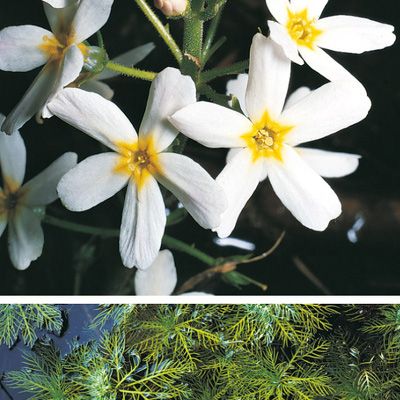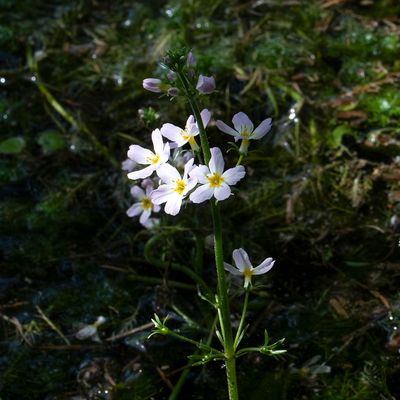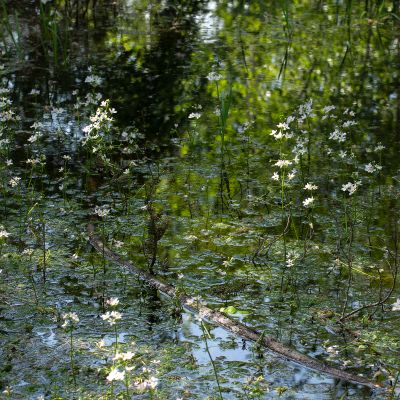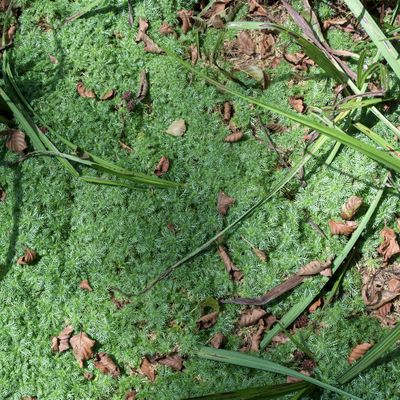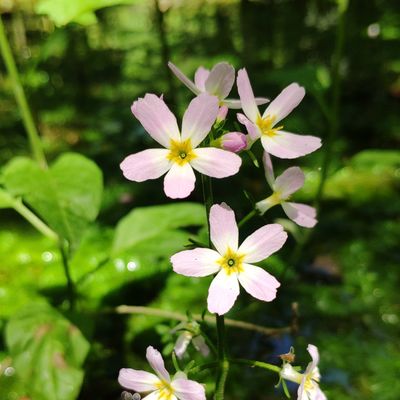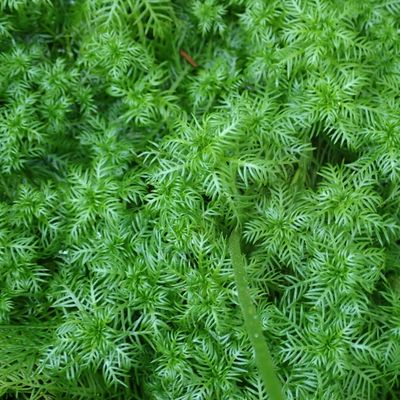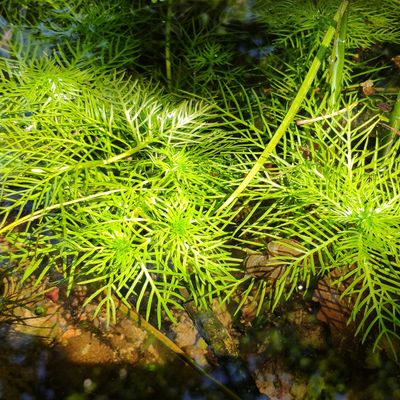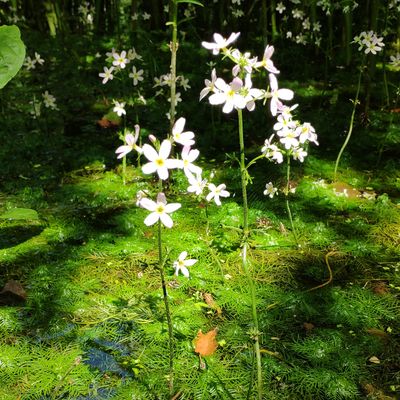Hottonia palustris L.
1023830
Species
ISFS : 208600
Checklist : 1023830
ISFS : 208600
Checklist : 1023830
Contains :
Synthesis
Species description (© Flora Helvetica 2018)
Wasserpflanze, im Schlamm wurzelnd, Stängel und Blätter untergetaucht. Blätter kammartig-fiederschnittig, Abschnitte bis 5 cm lang und 1,5 mm breit. Blütenstand aufrecht, aus dem Wasser ragend, aus übereinander stehenden Quirlen bestehend. Blüten weiss oder hellrosa, mit gelbem Schlund, Krone weit trichterförmig bis flach ausgebreitet, mit 7-9 mm langen Zipfeln. Kapsel ca. 5 mm lang.Flowering period (© Flora Helvetica 2018)
5-7Habitat and distribution inside Switzerland (© Flora Helvetica 2018)
Altwässer, Gräben / kollin / M, J, AN, auch oft angesiedeltWorld distribution (© Flora Helvetica 2018)
Europäisch-westasiatischEcological indicator (© Landolt & al. 2010)
5w+33-34+3.a.2n=20Status
IUCN status
EndangeredNational Priority
3 - medium national priorityInternational responsibility
1 - weakConservation
Threats
Eutrophierung (Landwirtschaft, Fischerei mit Fütterung und Kalkdüngung), Wasserverschmutzung, Algenbildung
Freizeitaktivitäten (Boots-, Badebetrieb, Angeln)
Ausbleibende Neubildung von Altwässern, natürliche Sukzession
Entwässerung, Trockenlegung oder Stauung
Vermischung mit Pflanzen unbekannter Herkunft
Wenige, isolierte Populationen
Distribution map
Habitat and distribution inside Switzerland
M, J, AN, auch oft angesiedeltWorld distribution
Europäisch-westasiatischEcology
Life form
Hydrophyte
Habitats
Milieux Phytosuisse (© Prunier et al. 2017)
Habitats © Delarze & al. 2015
 | 1.1.4 - Schwimmblattgesellschaft (Nymphaeion) |
bold
Dominant species, influencing the appearance of the habitat
 Character species
Character species
 Less strictly linked to a specific habitat
Less strictly linked to a specific habitat
Ecological indicator values by © Landolt & al. (2010)
| Soil factors | Climatic factors | Salinity tolerance | |||
|---|---|---|---|---|---|
| Humidity Value H | 5w+ | Light Value L | 3 | Salinity Index | -- |
| Reaction Value R | 3 | Temperature factor T | 4+ | ||
| Nutriments value N | 3 | Continentality K | 3 | ||
- Ecological values legend
Humidity Value H 1 very dry 1+ dry 2 moderatly dry 2+ moist 3 medium wet 3+ wet 4 very wet 4+ soggy 5 submerged or underwater f plants living in running water u mostly submerged plants v partly submerged, partly floating plants w humidity moderately variable (± scale of 1-2) w+ highly variable humidity (scale exceeding ± 2) Reaction Value R 1 Very acid (pH 2.5-5.5) 2 acid (pH 3.5-6.5) 3 lightly acid to neutral (pH 4.5-7.5) 4 neutral to basic (pH 5.5-8.5) 5 basic (pH 6-5 -> 8.5 Nutriments value N 1 very low in nutrients 2 low in nutriments 3 medium-poor to medium-rich in nutrients 4 rich in nutriments 5 very rich in nutriments Salinity tolerance 1 halotolerant 3 halophyle Light Value L 1 very shady 2 shady 3 lighted areas 4 luminous 5 highly luminous Temperature factor T 1 alpine to nival stages (from the treeline to the snowline) 1+ suprasubalpine and upper subalpine levels (pine and larch forests) 2 subalpine level (coniferous forests without beeches up to the upper limit of spruces) 2+ lower subalpine and upper mountain stages 3 mountain level (beech and silver fir forests, in the central Alps Scots pine forests) 3+ lower mountain and upper hill levels 4 hill level (mixed deciduous oak forests) 4+ hot places, hill level 5 very hot places, hill level (only in the hottest places, typical of southern Europe) Continentality K 1 Atlantic (high air humidity, very low temperature variations, mild winters) 2 Sub-Atlantic (high air humidity, low temperature variations, relatively mild winters) 3 sub-Atlantic to subcontinental (average air humidity, moderately variable temperature, slightly low winter temperatures) 4 subcontinental (low air humidity, large temperature variations, rather cold winters) 5 continental (very low air humidity, very large temperature variations, cold winters)
Water dependency
| Rivers | 1 - Secondary habitat |
| Calm water | 2 - Essential habitat |
| Ground water | 0 - No link |
Nomenclature
Accepted Name (Checklist 2017)
Hottonia palustris L.
Vernacular name
Deutscher Name :
WasserfederNom français :
Hottonie des marais, Millefeuille aquatiqueNome italiano :
Fertro, Erba scopinaMatch with other reference books
| Relation | Nom | Book | No |
|---|---|---|---|
| = | Hottonia palustris L. | Checklist 2017 | 208600 |
| = | Hottonia palustris L. | Flora Helvetica 2001 | 835 |
| = | Hottonia palustris L. | Flora Helvetica 2012 | 1379 |
| = | Hottonia palustris L. | Flora Helvetica 2018 | 1379 |
| = | Hottonia palustris L. | Index synonymique 1996 | 208600 |
| = | Hottonia palustris L. | Landolt 1977 | 2290 |
| = | Hottonia palustris L. | Landolt 1991 | 1864 |
| = | Hottonia palustris L. | SISF/ISFS 2 | 208600 |
| = | Hottonia palustris L. | Welten & Sutter 1982 | 1260 |
= The taxon corresponds to the accepted taxon (Checklist 2017)
< The taxon is included in the accepted taxon (Checklist 2017)
> The taxon includes (among others) also the accepted taxon (Checklist 2017)
< The taxon is included in the accepted taxon (Checklist 2017)
> The taxon includes (among others) also the accepted taxon (Checklist 2017)
Status
Native status
-IUCN list of endangered species (© Walter & Gillett 1997) : No
Status on national Red List 2016
IUCN status:
Endangered

Additional information
IUCN criteria: B2ab(iii,iv)
Status on regional Red List 2019
| Biogregraphic regions | Status | IUCN criteria |
|---|---|---|
| Jura (JU) | EN | B2ab(iii,iv) |
| Mittelland (MP) | EN | B2ab(iii,iv) |
| Alpennordflanke (NA) | EN | B2ab(iii,iv) |
| Alpensüdflanke (SA) | -- | |
| Östliche Zentralalpen (EA) | -- | |
| Westliche Zentralalpen (WA) | RE |
- Legend
EX Extinct RE Regionally Extinct CR(PE) Critically Endangered, Probably Extinct CR Critically Endangered EN Endangered VU Vulnerable NT Near Threatened LC Least Concern DD Data Deficient NE Not Evaluated NA Not Applicable
National Priority Species List Status
| National Priority | 3 - medium national priority |
| Need to take action | 2 - |
| International responsibility | 1 - weak |
| Need to monitor populations | 2 - |
Protection status
| International (Bern Convention) | No | |
| BE | total protection | (01.01.2016) |
| Switzerland | -- | |
| VD | total protection | (02.03.2005) |
- Disclaimer
InfoFlora compiles information on protected species as accurately as possible, taking it from the respective cantonal laws. In some cases, however, it was not possible to use the plant names as listed in the original text, but an interpretation of their taxonomy or nomenclature was necessary. The exact meaning of the categories „completely protected“ and „partially protected“ differs among the cantons.
InfoFlora cannot guarantee that the information on the protection status is correct and complete. In case of doubts, we recommend to look up the texts of the respective cantonal law.
Status by sector of activity
| Agriculture-related environmental objectives : | more informations | |
| Forest management environmental objectives : | more informations |
Conservation
Threats and measures
Eutrophierung (Landwirtschaft, Fischerei mit Fütterung und Kalkdüngung), Wasserverschmutzung, Algenbildung
Massnahmen zur Reduktion des Nährstoffgehalts in den Seen weiterführen, grosse Pufferzonen einrichten, Wasserverschmutzung verhindern
Freizeitaktivitäten (Boots-, Badebetrieb, Angeln)
Schutzzonen definieren, Lenkungsmassnahmen einleiten
Ausbleibende Neubildung von Altwässern, natürliche Sukzession
Durch Renaturierung vermehrt natürliche Dynamik in Flusstälern fördern (aktuelle Vorkommen schonen)
periodisch geeignete Lebensräume schaffen (Weiherbiotope)
Entwässerung, Trockenlegung oder Stauung
Keine negativen Veränderungen
Vermischung mit Pflanzen unbekannter Herkunft
Falls Ansiedlungen vorgenommen werden, diese nur mit Material bekannter, einheimischer oder grenznaher Herkunft (je nach Region) zulassen
Wenige, isolierte Populationen
Schutz inkl. Pufferzonen (z.B. Mikroreservate), regelmässige Bestandeskontrollen, Erfolgskontrolle der Massnahmen gewährleisten
